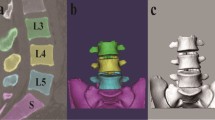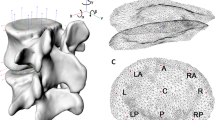Abstract
Introduction
Examination with CT and image registration is a new technique that we have previously used to assess 3D segmental motions in the lumbar spine in a phantom. Current multi-slice computed tomography (CT) offers highly accurate spatial volume resolution without significant distortion and modern CT scanners makes it possible to reduce the radiation dose to the patients. Our aim was to assess segmental movement in the lumbar spine with the aforementioned method in healthy subjects and also to determine rotation accuracy on phantom vertebrae.
Material and method
The subjects were examined in flexion–extension using low dose CT. Eleven healthy, asymptomatic subjects participated in the current study. The subjects were placed on a custom made jig which could provoke the lumbar spine into flexion or extension. CT examination in flexion and extension was performed. The image analysis was performed using a 3D volume fusion tool, registering one of the vertebrae, and then measuring Euler angles and distances in the registered volumes.
Results
The mean 3D facet joint translation at L4–L5 was in the right facet joint 6.1 mm (3.1–8.3), left facet joint 6.9 mm (4.9–9.9), at L5–S1: right facet joint 4.5 mm (1.4–6.9), and for the left facet joint 4.8 mm (2.0–7.7). In subjects the mean angles at the L4–L5 level were: in the sagittal plane 14.3°, coronal plane 0.9° (−0.6 to 2.8), and in the transverse plane 0.6° (−0.4 to 1.5), in the L5–S1 level the rotation was in sagittal plane 10.2° (2.4–16.1), coronal plane 0° (−1.2 to 1.2), and in the transverse plane 0.2° (−0.7 to 0.3). Repeated analysis for 3D facet joint movement was on average 5 mm with a standard error of mean of 0.6 mm and repeatability of 1.8 mm (CI 95%). For segmental rotation in the sagittal plane the mean rotation was 11.5° and standard error of mean 1°. The repeatability for rotation was 2.8° (CI 95%). The accuracy for rotation in the phantom was in the sagittal plane 0.7°, coronal plane 1°, and 0.7 in the transverse plane.
Conclusion
This method to assess movement in the lumbar spine is a truly 3D method with a high precision giving both visual and numerical output. We believe that this method for measuring spine movement is useful both in research and in clinical settings.







Similar content being viewed by others
References
Dvorak J, Panjabi MM, Chang DG, Theiler R, Grob D (1991) Functional radiographic diagnosis of the lumbar spine. Flexion-extension and lateral bending. Spine 16:562–571
Frobin W, Brinkmann P, Leviseth G, Biggemann M, Reikerås Presion O (1996) Measurement of segmental motion from flexion–extension radiograph of lumbar spine. Clin Biomech 8:457–465
Hayes MA, Howard TC, Gruel CR et al (1989) Roentgenographic evaluation of lumbar spine flexion–extension in asymptomatic individuals. Spine 14:327–331
Wall MS, Oppenhiem WL (1995) Measurement error of spondylolisthesis as a function of radiographic beam angle. J Pediatr Ortopedic 15:193–198
Pearcy M, Portek I, Shepherd J (1984) Tree-dimensional X-ray analysis of normal movement in the lumbar spine. Spine 9(3):294–297
Pearcy MJ (1985) Stereo radiography of lumbar spine motion. Acta Orthop Scand Suppl 212:1–45
Dickey JP, Pierrynowski MR, Bednar DA et al (2002) Relationship between pain and vertebral motion in chronic low-back pain subjects. Clin Biomech (Bristol, Avon) 17:345–352
Axelsson P, Karlsson BS (2005) Standardized provocation of lumbar spine mobility: three methods compared by radiostereometric analysis. Spine 7:792–797
Johnsson R, Selvik G, Strömkvist B, Sunden G (1990) Mobility of the lower lumbar spine after posterolateral fusion determined by roentgen stereophotogrammetric analysis. Spine 15(5):347–350
Steffen T, Rubin R, Baramki K, Hani G, Antoniou J, Marchesi D, Aebi M (1997) New technique for measuring lumbar segmental motion in vivo: method, accuracy, and preliminary results. Spine 22(2):156–166
Ochia RS, Inoue N, Renner SM, Lorenz EP, Lim TH, Andersson GB, An HS (2006) Three-dimensional in vivo measurement of lumbar spine segmental motion. Spine 31(18):2073–2078
Ochia RS, Inoue N, Takatori R, Andersson GB, An HS (2007) In vivo measurements of lumbar segmental motion during axial rotation in asymptomatic and chronic low back pain male subjects. Spine 32(13):1394–1399
Svedmark P, Weidenhielm L, Nemeth G, Tullberg T, Noz ME, Maguire GQ Jr, Zeleznik MP, Olivecrona H (2008) Model studies on segmental movement in lumbar spine using a semi-automated program for volume fusion. Comput Aided Surg 13(1):14–22
Noz ME, Maguire GQ Jr, Zeleznik MP, Kramer EL, Mahmoud F, Crafoord J (2001) A versatile functional-anatomic image fusion method for volume data sets. J Med Syst 295:297
Noz ME, Maguire GQ Jr (1988) A minimal but highly portable image display and handling toolkit. Comput Meth Programs Biomed 27:229
Olivecrona L, Crafoord J, Olivecrona H, Noz ME, Maguire GQ, Zeleznik MP, Svensson L, Weidenhielm L (2002) Acetabular component migration in total hip arthroplasty using CT and a semiautomated program for volume merging. Acta Radiol 43(5):517–527
Olivecrona H, Olivecrona L, Weidenhielm L, Noz ME, Maguire GQ, Zeleznik MP, Svensson L, Jonson T (2003) Stability of acetabular axis after total hip arthroplasty, repeatability using CT and a semiautomated program for volume fusion. Acta Radiol 44(6):653–661
Olivecrona L, Olivecrona H, Weidenhielm L, Noz ME, Maguire GQ Jr, Zeleznik MP (2003) Model studies on acetabular component migration in total hip arthroplasty using CT and a semiautomated program for volume merging. Acta Radiol 44(4):419–429
Ranstam J et al (2000) Accurate accuracy assessment: review of basic principles. Acta Orthop Scand 71:106–108
Rozumalski A, Schwartz MH, Wervey R, Swanson A, Dykes DC, Novacheck T (2008) The in vivo three-dimensional motion of the human lumbar spine during gait. Gait Posture 28(3):378–384
AAPM report no 96 (2008) The Measurement, Reporting, and Management of Radiation Dose in CT-Report of AAPM Task Group 23 of the Diagnostic Imaging Council CT Committee
Conflict of interest
None.
Author information
Authors and Affiliations
Corresponding author
Rights and permissions
About this article
Cite this article
Svedmark, P., Tullberg, T., Noz, M.E. et al. Three-dimensional movements of the lumbar spine facet joints and segmental movements: in vivo examinations of normal subjects with a new non-invasive method. Eur Spine J 21, 599–605 (2012). https://doi.org/10.1007/s00586-011-1988-y
Received:
Accepted:
Published:
Issue Date:
DOI: https://doi.org/10.1007/s00586-011-1988-y




